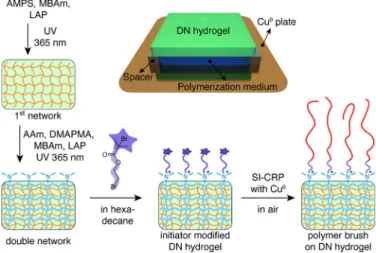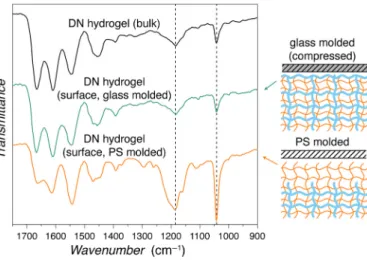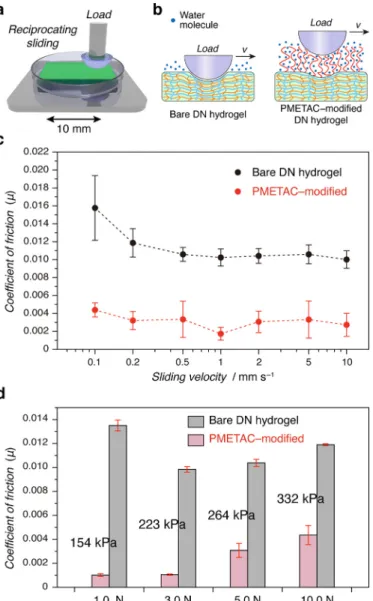Research Collection
Journal Article
Imparting ultralow lubricity to double-network hydrogels by surface-initiated controlled radical polymerization under ambient conditions
Author(s):
Zhang, Kaihuan; Simic, Rok; Spencer, Nicholas D.
Publication Date:
2021-06
Permanent Link:
https://doi.org/10.3929/ethz-b-000472074
Originally published in:
Biotribology 26, http://doi.org/10.1016/j.biotri.2021.100161
Rights / License:
Creative Commons Attribution-NonCommercial-NoDerivatives 4.0 International
This page was generated automatically upon download from the ETH Zurich Research Collection. For more information please consult the Terms of use.
ETH Library
Biotribology 26 (2021) 100161
Available online 11 February 2021
2352-5738/© 2021 The Authors. Published by Elsevier Ltd. This is an open access article under the CC BY-NC-ND license
(http://creativecommons.org/licenses/by-nc-nd/4.0/).
Imparting ultralow lubricity to double-network hydrogels by surface-initiated controlled radical polymerization under ambient conditions
Kaihuan Zhang, Rok Simic, Nicholas D. Spencer *
Laboratory for Surface Science and Technology, Department of Materials, ETH Zurich, 8093 Zurich, Switzerland
A R T I C L E I N F O Keywords:
Double-network hydrogels Interfacial reactions
Surface-initiated polymerization Surface modification Polymer brushes
A B S T R A C T
Hydrogels, especially double-network hydrogels, are attractive candidates as load-bearing biomaterials, e.g., tissue-engineering supports for articular cartilages and bones. In this study, we describe the modification of a double-network hydrogel by the introduction of a third monomer, N-[3-(dimethylamino)propyl]meth- acrylamide, to the network system, which serves as a reactive site for subsequent interfacial reactions and surface-initiated controlled radical polymerization under ambient conditions. The as-prepared poly(2-(meth- acryloyloxy)ethyl trimethylammonium chloride) (PMETAC) polyelectrolyte polymer brush-modified DN hydrogel exhibited an ultralow coefficient of friction (0.001 – 0.004) under high contact pressure — comparable to that of the synovial joint.
1. Introduction
Hydrogels are composed of cross-linked macromolecules and a large amount of water. Owing to their similarity to soft biological tissues, hydrogels have been widely used in biomaterials and bioengineering, in applications such as bio-scaffolds for in vitro cell culturing [1], bio- adhesives [2], drug-delivery systems [3,4], artificial tissues or organs [5], and recently as skin electronics [6]. Bioinspired and biomimetic hydrogel materials (e.g., artificial articular cartilage) have garnered great interest over the last two decades, interpenetrating polymer network (IPN) and double-network (DN) hydrogels having been used extensively as a load-bearing substrate with the aim of mimicking some of the functionality of natural cartilage [7 – 9].
One important aspect of the performance of cartilage is its extremely low friction, which is attributed in part to the superficial structure of the sliding surfaces, but also to the presence of a lubricating layer of syno- vial fluid. Osada and coworkers prepared DN hydrogels with an addi- tional linear polyelectrolyte polymer to provide a lubricating layer, and obtained friction coefficients below 10
−4at very low speeds [10]. Zhou and coworkers also reported a bioinspired, dual cross-linked hydrogel that combined high load-bearing properties with ultralow friction [11].
A soft, porous top layer was imparted to the bilayer hydrogel, analo- gously to the structure of articular cartilage, and it was obtained by
means of interfacially modulated polymerization. The reported bilayer hydrogel achieved a coefficient of friction of 0.01–0.05 at contact pressures between 2.0 and 3.7 MPa. A most recent study by Klein et al.
reported a self-lubricating lipid-based boundary layer that can contin- uously lubricate the exposed, or the worn surface of the lipid- incorporating composite hydrogel [12].
The ability to precisely control surface properties plays a pivotal role in the fabrication of artificial tissues or organs that can mimic their native counterparts. The development of an efficient synthetic method to selectively modify the exposed surfaces of a hydrogel substrate could widen the applicability and enrich the range of properties of such bio- materials [13–15]. Controlled radical polymerization techniques, e.g., reversible addition fragmentation chain-transfer polymerization (RAFT) and atom transfer radical polymerization (ATRP), have been proven to be effective methods for the modification of the polymer networks [16,17]. However, previously reported methods for modification of hydrogels by controlled radical polymerization have typically been applied throughout the entire network structure, instead of being purely confined to the materials’ surfaces [18–20].
In our recent study, modulation of the interfacial properties (inde- pendently from their bulk properties) of single-network, poly(2- hydroxyethyl methacrylate-co-N-vinyl-2-pyrrolidone), P(HEMA-NVP) hydrogels was enabled by applying a Cu
0-supported surface-initiated
* Corresponding author.
E-mail address: nspencer@ethz.ch (N.D. Spencer).
Contents lists available at ScienceDirect
Biotribology
journal homepage: www.elsevier.com/locate/biotri
https://doi.org/10.1016/j.biotri.2021.100161
Received 30 November 2020; Received in revised form 28 January 2021; Accepted 2 February 2021
Biotribology 26 (2021) 100161
2
controlled radical polymerization (SI-CRP) approach [21]. By means of this method, hydrogels with a range of surface properties could be successfully synthesized, including a hydrogel with a hydrophobic sur- face barrier, a lubricious hydrogel, and a hydrogel with thermally switchable frictional properties [21]. However, single-network hydro- gels have a few limitations in terms of toughness, stiffness, and other potential functionalities. In the present study, we have explored the SI- CRP on a PAMPS/P(AAm-DMAPMA) DN hydrogel substrate, and demonstrated the fabrication of spatially structured DN hydrogel- polymer brush interfaces with enhanced lubrication and load-bearing properties.
2. Materials and methods 2.1. Materials
2-Acrylamido-2-methylpropane sulfonic acid (AMPS), acrylamide (AAm), N-[3-(dimethylamino)propyl]methacrylamide (DMAPMA), N, N
′-methylenebis(acrylamide) (MBAm), oligo(ethylene glycol) methyl ether acrylate (OEGA, average M
n480), 2-methacryloyloxyethyl phos- phorylcholine (MPC), 2-(methacryloyloxy)ethyltrimethylammonium chloride (METAC, 75 wt% in H
2O), N, N, N
′, N
′, N
′′-pentam- ethyldiethylenetriamine (PMDETA), hexadecane, and dichloromethane were purchased from Sigma-Aldrich (MO, USA). Copper plates (99.9%) were obtained from Conrad Electronic AG (Wollerau, Switzerland).
Lithium phenyl-2,4,6-trimethylbenzoylphosphinate (LAP, UV initiator) and 2-bromoethyl α -bromoisobutyrate (C2 – Br modifier) were synthe- sized according to the previous reports [21,22].
2.2. Synthesis of the DN hydrogel
The DN hydrogel synthesis procedure was modified from that of Gong et al. [9]. The first network, a PAMPS hydrogel, was synthesized by UV crosslinking of an aqueous solution of 1 M AMPS monomer containing 4 mol% MBAm and 0.1 mol% UV initiator LAP (molar ratio to the total monomer content). The reaction medium was placed be- tween two glass plates with a 1 mm spacing. The solution was cured horizontally under UV irradiation (λ = 365 nm, 1.2 mW cm
−2) in a Stratalinker UV Crosslinker 2400 (Stratagene, La Jolla, CA, USA) at room temperature for 6 h to obtain a single-network hydrogel. The first- network hydrogel was punched to 40 mm diameter discs, and was subsequently immersed in an aqueous solution of 2 M AAm and 1 M DMAPMA, containing 0.1 mol% (molar ratio to the total monomer) MBAm and 0.1 mol% LAP for 48 h. The second network was UV poly- merized for 6 h under compression of two glass plates at a pressure of 5.0 kPa. The as-prepared DN hydrogels were thoroughly washed with milli-Q water and the residual water on the hydrogel surface was removed under a N
2flow. Subsequently, the swollen hydrogel was immersed in a hexadecane or hexadecane-dichloromethane mixture (1:1, v/v) solution with C2 – Br modifier (1 wt%) for 24 h. After the surface treatment, the hydrogel was thoroughly rinsed with ethanol and milli-Q water.
2.3. Cu
0-mediated controlled radical polymerization on DN hydrogel surface
A copper plate (0.5 mm thickness, 10 × 10 cm) was washed with 4 M HCl for 5 min and dried under N
2. The initiator-modified DN hydrogel substrate was supported above the copper plate leaving a gap of ~0.5 mm with the aid of two Si wafer shims. A polymerization mixture including monomer (2 M) and PMDETA (50 mM) in water was injected into the gap by using a pipette and the reaction was left under ambient conditions for 30 min. The hydrogel samples were cleaned with milli-Q water and stored until further measurement.
2.4. Instruments and characterization
FTIR spectra were obtained by a Bruker ALPHA spectrometer (Bruker Optik GmbH, Ettlingen, Germany) equipped with a single-reflection diamond attenuated-total-reflection (ATR) accessory. The Young’s moduli of the hydrogel samples were measured by an indentation test with a 2 mm radius, cylindrical indenter using a TA.XT plus Texture Analyser with a 500 g load cell (Stable Micro Systems, Godalming, UK).
2.5. Pin-on-disc tribological test
Friction tests were performed on a pin-on-disc tribometer (Standard Tribometer, model: TRB, CSM Instruments, Peseux, Switzerland). DN hydrogel samples with 2 mm thickness were fixed to the base of poly- styrene petri dishes with ethyl cyanoacrylate based super glue (Pattex, Henkel KGaA, Düsseldorf, Germany). A glass hemisphere of diameter 18 mm was employed as a countersurface. The stroke length was set to 10 mm, and sliding speeds were varied from 0.1 – 10 mm/s. The normal load was set to 1–10 N. The contact depth is ~0.5 mm at the highest load of 10 N. The coefficient of friction ( μ ) was defined as the friction force divided by the normal load and was determined for each cycle from the middle 20% of the stroke length. The loading time was varied between 1 min and 60 min for the measurement at different sliding speeds. During the measurement, the samples were fully immersed in milli-Q water at room temperature. In each measurement, the coefficient of friction was calculated from the average of the last 6 sliding cycles. Friction values presented are mean values from at least 3 repetitions of the measure- ment at a set sliding speed and load.
3. Results and discussion
By using a modified, two-step UV crosslinking method described by Gong et al. [9], we synthesized the PAMPS/P(AAm-DMAPMA) DN hydrogel, in which the neutral polymer network, P(AAm-DMAPMA) is incorporated within a highly swollen polyelectrolyte, PAMPS network.
MBAm and LAP were used as the cross-linker and the UV initiator, respectively, in both the first and the second network. The mechanical properties of DN hydrogels were shown to be much improved over those of the individual components, and are comparable to soft, load-bearing tissues, such as articular cartilage. DMAPMA was copolymerized within the second network to introduce a dimethylamino functional group throughout the structure. As illustrated in Fig. 1, a surface modifier, 2- bromoethyl α -bromoisobutyrate (C2 – Br modifier) can be selectively attached to the surface of the DN hydrogel through an interfacial
Fig. 1. Preparation process of the polymer brush-modified DN hydrogel via interfacial modification and subsequent grafting polymerization. The top insert shows a sandwiched liquid cell, used for the surface-initiated controlled radical polymerization with the aid of a Cu
0plate.
K. Zhang et al.
quaternization reaction in hexadecane between the dimethylamino groups and the alkyl bromide [21]. Various polymer brushes were grafted to the surface of the DN hydrogels by using surface-initiated controlled radical polymerization with the aid of a copper plate as the catalyst source.
When a negatively charged PAMPS hydrogel is used as the first network and formed against a glass mold, the electrostatic repulsion at the hydrogel-glass interface leads to a gap, which upon the introduction of the second network, becomes filled by a layer of the latter. Thus, the final DN hydrogel is covered by a thin layer of the second network [23].
In order to overcome this, the first network, the PAMPS hydrogel, was prepared in a glass mold. After full immersion of the first network in a AAm-DMAPMA monomer solution, additional compression (approxi- mately 5.0 kPa) was applied to the glass and PAMPS hydrogel during the second network formation to overcome the electrostatic forces and avoid the surface heterogeneity of the DN hydrogel.
The use of a polystyrene (PS) mold was also considered, as a means of avoiding the electrostatic issue. Previous studies have suggested that the surface properties of single-network hydrogels (e.g., PAAm hydrogel and PAMPS hydrogel) could be regulated by synthesizing them in molds of different surface energies [24–26]. A hydrogel exhibits a much lower friction when it is synthesized against a polymer substrate such as PS, which is due to the formation of a softer and sparser surface structure during the polymerization of the hydrogel [24,25]. However, the surface effects of the molding substrate are more complex in a PAMPS/PAAm double-network system [10,23].
Fig. 2 shows the ATR-FTIR spectra of the bulk DN hydrogel, and the DN hydrogel molded in a compressed glass mold and a PS mold during the second polymerization. The spectra of the bulk DN hydrogel, and the surface of the DN hydrogel molded in glass under compression exhibit similar profile and transmittance intensities at 1184 and 1042 cm
−1, which are ascribed to the characteristic sulfonate groups in PAMPS network. However, the spectrum of the DN hydrogel sample molded in a PS mold exhibits stronger characteristic signals for those two peaks, indicating that a higher PAMPS fraction was exposed on the hydrogel surface, and thus a less homogeneous network structure was formed for the PS-molded sample. We therefore used the compressed, glass-molded DN hydrogel as the substrate for the subsequent surface modification by polymer brushes due to its homogeneous network structure and rela- tively higher concentration of dimethylamino groups introduced by the second network.
The surface-anchored α -bromoisobutyrate was further employed as
an ATRP initiator to graft a polymer brush onto the DN hydrogel via surface-initiated controlled radical polymerization. By using a sand- wiched reaction cell under ambient conditions, compositionally diverse polymer brushes can be readily grown from the hydrogel surface, including poly(oligo(ethylene glycol) acrylate) (POEGA), poly(2- methacryloyloxyethyl-trimethylammonium chloride) (PMETAC), and poly(2-methacryloyloxyethyl phosphorylcholine) (PMPC). The ATR- FTIR spectra in Fig. 3 showed characteristic signals of each polymer, confirming the successful growth of these three polymer brushes from the hydrogel surface.
Indentation tests were employed to study the mechanical properties of the bare DN hydrogel and the polymer brush-modified DN hydrogel. A rigid steel cylinder of radius R with a flat end was pressed onto the surface of the hydrogel sample (Fig. 4a). Fig. 4b shows representative force − distance curves measured on the different samples. The rela- tionship between the normal force (F) and the indentation depth (d) is given by:
F = 2RE
*d.
E* = E / (1 – ν
2) is the reduced elastic modulus, E and ν are the Young ’ s modulus and Poisson ’ s ratio of the indented hydrogel surface.
When a hydrogel material is fully swollen, its mechanical behavior can be considered as similar to that of rubber-like materials [27], which have a Poisson’s ratio of ~0.5. Thus, the Young’s moduli of the tested samples can be extracted from the force − distance curves by using the following equation:
E = E
*(
1– ν
2) = 3F 8Rd.
Both the bare DN hydrogel and the polymer-brush-modified DN hydrogel exhibited a relatively high Young’s modulus with force − - distance curves that could be linearly fitted within 0.5 mm indentation depth. The obtained elastic moduli were around 1.76 MPa and 1.71 MPa for the bare DN hydrogel and the polymer brush-modified DN hydrogel, respectively. The mechanical properties of the polymer-brush-modified DN hydrogel remained almost unchanged after the surface modification.
Previous reports have shown that linear polyelectrolyte chains on a single-network hydrogel surface [21,24], or embedded into the DN hydrogel matrix [10], can effectively reduce the μ due to the repulsive interaction against the countersurface. The formation of a highly swollen polyelectrolyte polymer layer on a DN hydrogel via SI-CRP has led to ultralow frictional behavior. A standard pin-on-disc tribological test was employed to measure friction on the PMETAC-modified DN
Fig. 2. ATR-FTIR spectra of the bulk DN hydrogel (measured from the surface of a cut hydrogel), and the surface of DN hydrogel molded in a compressed glass mold and a PS mold. On the right, the first network (PAMPS) is shown in or- ange, the second network (P(AAm-DMAPMA)) in blue. (For interpretation of the references to colour in this figure legend, the reader is referred to the web
version of this article.) Fig. 3. ATR-FTIR spectra of the bare DN hydrogel, and polymer brushes grafted
on the hydrogel surface, including POEGA, PMETAC, and PMPC.
Biotribology 26 (2021) 100161
4


